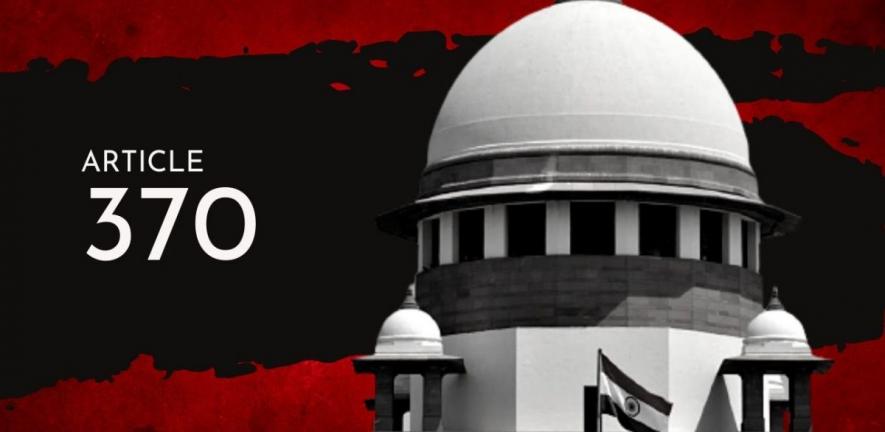Article 370 Verdict: A Missed Opportunity to Rein in an Unrestrained Exercise of Power

Image credit: The Leaflet
Four years after Article 370 was de-operationalised, the Supreme Court has held the Presidential Orders [Constitution (Application to Jammu and Kashmir), Order 2019 or CO 272 and Declaration Under Article 370(3) of the Constitution or CO 273] and the Jammu and Kashmir Reorganisation Act, 2019 constitutionally valid.
However, the rationale used by the Supreme Court to reach the conclusions was stretched and did little to enhance confidence in the judicial process.
Nor did the judgment do much to restore the statehood of Jammu and Kashmir (J&K), which itself would not be anything more than a consolation for the people of the State.
In any case, the judgment merits a closer look.
Nature of power contained in Article 370(3)
In the judgment, the Supreme Court concludes, “The power under Article 370(3) did not cease to exist upon the dissolution of the Constituent Assembly of Jammu and Kashmir.
“When the Constituent Assembly was dissolved, only the transitional power recognised in the proviso to Article 370(3) which empowered the Constituent Assembly to make its recommendations ceased to exist.
“It did not affect the power held by the President under Article 370(3).”
In other words, the President can unilaterally exercise power under Article 370(3). Nothing could be further from the plain reading of the clause, let alone when the context elucidates the clause.
A plain meaning makes it clear that the final shape of the relationship between the Union and J&K was to be decided by the Constituent Assembly of the state.
This is in no way a manifestation of any separate sovereignty of the state but is a specific provision in the Constitution of India itself. The provision does not arrogate the supremacy of the Constitution of India but is an inalienable part thereof.
Thus, as per the Constitution of India, under Clause (3) of Article 370, it was specifically for the Constituent Assembly of J&K to frame the Constitution for the state and to decide the fate of Article 370, as envisaged under the then Article 306 A.
After the Constituent Assembly of J&K was dissolved, the framework of constitutional law for J&K comprised Article 370 of the Constitution of India, the Constitution of J&K as well as Acts and Orders issued thereunder.
Therefore, to conclude that the President can unilaterally exercise power under Article 370(3) and dissolve Article 370 could not be any further from the plain reading of the text of 370(3).
This interpretation also finds support in the detailed exposition of Article 370 in the Constituent Assembly debates by N. Gopalaswami Ayyangar, an Indian civil servant and statesman who worked as the Prime Minister of the princely state of J&K and thereafter as a minister in the very first cabinet of independent India, and served on the Indian Constitution’s drafting committee.
Ayyangar writes: “[S]o the provision is made that when the Constituent Assembly of the State has met and taken its decision both on the Constitution for the State and on the range of federal jurisdiction over the State, the President may on the recommendation of that Constituent Assembly issue an Order that this Article 306A shall either cease to be operative, or shall be operative only subject to such exceptions and modifications as may be specified by him.
“But before he issues any Order of that kind, recommendation of the Constituent Assembly will be a condition precedent. That explains the whole of this Article.”
Thus, it is clear that Article 370 was ‘temporary or transitional’ till the Constituent Assembly had sat and decided upon the final and permanent nature of the relationship between the Union of India and the State of J&K.
Hence, once the Constituent Assembly was dissolved after framing the Constitution for J&K and without recommending “cessation of the operation of Article 370”, what was to be permanent was the framework of law comprising Article 370 of the Constitution of India, the Constitution of J&K as well as Acts and Orders issued thereunder.
The Constituent Assembly of J&K had not specified any “exceptions or modifications” for the continued operation of Article 370. Thus, the article had gained a permanent character according to the text of Article 370 itself.
It also follows that the issue of the effect on the power of the President under Article 370(3) does not arise.
Temporariness or transitional nature
The Supreme Court proceeded to put forth a rationale for the temporariness of Article 370. According to the court, “It can be garnered from the historical context for the inclusion of Article 370 and the placement of Article 370 in Part XXI of the Constitution that it is a temporary provision.”
It is redundant to say that temporariness is a relative concept. A thing, entity or provision is temporary till (a) a specified time, or (b) certain conditions are met.
Article 370 does not specify any time but it clearly mentions the condition under which and the form in which the Article shall operate or cease to operate, i.e., upon and as per the recommendation of the Constituent Assembly of J&K, as elucidated above.
Process of integration
The Supreme Court further relies on the rationale that “the continuous exercise of power under Article 370(1) by the President indicates that the gradual process of constitutional integration was ongoing. The declaration issued by the President under Article 370(3) is a culmination of the process of integration and as such is a valid exercise of power. Thus, CO 273 is valid.”
The very usage of word “integration” is misplaced, and contradictory to other assertions in the very judgment, i.e., that J&K did not retain any element of sovereignty after the execution of the Instrument of Accession and issuance of the Proclamation dated November 25, 1949 by which the Constitution of India was adopted.
J&K has been an integral part of India and this line of argument is a recognition of the same.
Thus, to say that integration is complete only after CO 272 and CO 273 is a manifest contradiction in the judgment.
What was continuing was the gradual application of further provisions of the Constitution of India, and not the process of integration. What was changing was the nature of asymmetrical federalism in relation to J&K, and not the quantum of integration.
Nothing emaciates a judgment as a manifest contradiction. It gives the impression that the rationale has been forced to reach a conclusion. This ought to be protected against.
Even in the case of the application of further provisions of the Constitution, the procedure enshrined in Article 370(1)(d) ought to have been followed. Even if it is assumed that “concurrence of the government of the State” stood dispensed with, since J&K was under President’s rule, such exercise of power could not have been in violation of the Constitution of J&K.
It lay beyond the powers of even a duly elected government of J&K to make recommendations in violation of the provisions of the Constitution of J&K, since the same avails the protection of the Constitution of India. The process of issuance of CO (272), thus, stood vitiated.
Furthermore, is the issuance of CO 272 not an exercise of power under Article 370(3) through the backdoor? Can the averment, right or wrong, that since the President enjoyed similar power under Article 370 (3), so he could issue CO 272 under Article 370(1)(d) cure the time-honoured doctrine of substance over form?
In my humble opinion, the Constitution of India frowns upon such coloured exercise of power.
Future of Article 370
A major issue is whether it is open for a future government to re-introduce the original provisions of Article 370 through an executive Order? Since the cessation of Article 370 has been effected through executive Orders and parliamentary resolutions, and not through an amendment under Article 368, the constitutional door remains open for the reintroduction of the original provisions, though it is highly unlikely any future government would wade into these troubled waters.
But what is problematic to the greatest degree is the suspect and circuitous manner in which the changes to Article 370 were brought about. The method has been questioned by legal luminaries including former judges of the Supreme Court.
It opens the Constitution of India to gross abuse by any unconscientious government in the future. The same endangers the constitutional and other values we hold dear as a society.
Federal structure
Another problematic aspect of this judgment is the interpretation of Article 3 of the Constitution, which is read to provide all-encompassing power to the Union government to alter the territory or status of a state without reading any limitations to such power.
A logical question is whether the Union government can unilaterally convert all states into Union territories and govern them directly. Will that not be against the federal character of the Constitution?
If yes, when and how is the federal character threatened?
Given the language used in Article 3 and the limited scope of this judgment in relation to the same, one cannot be too excited over this aspect of the judgment.
But these questions are of prime significance, and ought to be dealt with by an appropriate future Bench of the Supreme Court which ought to delineate the contours of power contained in Article 3 and limitations on such power.
Also, the undertaking of the Union government that the statehood of J&K will be restored or that elections will be held at the earliest does little to cure the erosion of constitutional principles.
It will not be far-fetched to say that this judgment is a missed opportunity to rein in an unrestrained exercise of power.
What was at stake was the principle of “limited government”. What was and is threatened is the much-vaunted natural rights of citizens.
Such a situation requires a constant and heightened vigil by the judiciary.
What the judgment ended up with is to validate an act that tested the elastic limits of the tether that binds the government to the Constitution.
Mohammad Wasim is an advocate practising in the Supreme Court of India and the High Court of Delhi. He also works in the rural education sector. The views are personal.
Get the latest reports & analysis with people's perspective on Protests, movements & deep analytical videos, discussions of the current affairs in your Telegram app. Subscribe to NewsClick's Telegram channel & get Real-Time updates on stories, as they get published on our website.
























